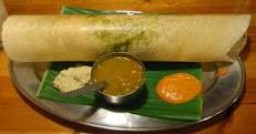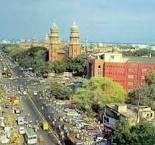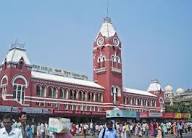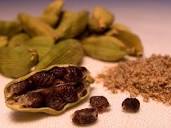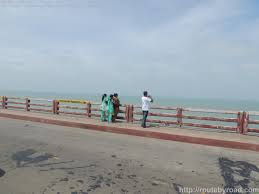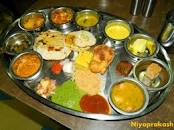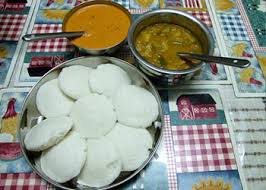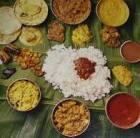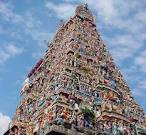Chennai, biggest city in Tamil Nadu, is packed with eating options. Where to begin?
By the time I tumble out of a crowded overnight train from Kolkata, I’m ready to stretch my legs, breathe some fresh sea air and find authentic south Indian food. From Chennai’s beehive-busy station, one of the focal points in this densely populated city of 8 million people, I hail a taxi.
“Where’s the best masala dosa in town?” I ask the portly driver.
“I’m taking you to my cousin’s café, sir. Where are you from? Do you have money so we can be buying fuel as my taxi is empty?” He responds in Indian fashion, mixing questions with surprising statements. We fill his tank and head into a rabbit-warren market.
The driver finds a parking spot next to two cows chewing sugar canes. He takes me into his cousin’s cafe and yells out that this gentleman from Kolkata wants a masala dosa. I offer to buy him one too but he declines, saying his taxi business mustn’t be kept waiting.
Within minutes cousin Balaji brings me a freshly cooked, crispy dosa pancake whose edges easily extend over my banana-leaf plate. It’s filled with a warm potato curry accompanied by two little bowls: one of coconut sambar; the other a soupy tomato and lentil rasam. I wash my hands at a grimy basin, roll up my sleeves and tuck in.
I taste fresh curry leaves, a hint of chilli, black pepper, acidic lime juice, mustard seeds, astringent chopped cabbage, onions and bitter fenugreek in the curry. The airy, flaky dosa is slightly sour from its fermented rice flour batter. The sambar is fiery hot; a touch of sweetness is imparted by creamy coconut and it’s lightly salted. The rasam is even hotter with chilli, and it’s pungent with and coloured by turmeric. I have a glass of plain lassi, fresh yoghurt blended with cool water and a bit of salt. Then I finish with a tiny local banana.
It isn’t the best masala dosa I’ve ever eaten but it is memorable for its authenticity. Within an hour of arrival I’m eating one of Chennai’s signature dishes. It’s fresh and lively and completely vegetarian: healthy and true to the city’s essential flavours. Simply, it’s Chennai on a plate.
This capital of the Coromandel Coast is a fabled place. Arabs traded here when they dominated commerce between Asia and Europe. In exchange for cardamom, cinnamon and peppercorns, the locals obtained sandalwood, frankincense and myrrh. A spice bazaar was born; prices skyrocketed faster than a fakir could shimmy up a rope trick. Europeans developed an addiction for the aromatic masalas, as they’re known in India, giving depth and richness to bland northern European fare. By the 17th century, the Portuguese were trading along the southern Indian coast, adding their own Lusitanian influences to the regional cuisine. They were followed successively by both the English and the French. In the 19th century the English were reaping riches from the Coromandel Coast. They called the collection of towns packed together here along this busy harbour, Madras. In 1996, along with a return to traditional pronunciations and historic associations that many other Indian cities experienced, Madras became Chennai.
Entrepreneurs introduced chillies, tomatoes and potatoes from South America to southern India. Locals took to these extraordinary new ingredients with gusto, and their export trade continued to prosper. By 1600, cardamom from Coromandel was worth more than gold.
The coast brims with tropical tastes, mingling hot and sizzling with cool and seductive. Local chefs have constantly innovated, seeking new ways to use ingredients from all over the world. They exported their ingenuity as well: the Tamil word kari, or black pepper, was anglicised to curry.
I love eating in Chennai. Certainly, food hygiene is a challenge, though fortunately I have a cast-iron stomach. Other visitors to Chennai I’ve known haven’t been so lucky. Shun unwashed fruits, vegetables and tap water. Avoid the dodgiest food stalls. Nonetheless, be prepared for digestive complaints – they’re unavoidable. You’ve heard of Delhi Belly? Wait till you experience Chennai Chunder.
Coromandel cuisine, or Chennai cooking, is best known for its vegetarian, fish, seafood and rice-based dishes. This sturdy quartet of local ingredients has altered little over the centuries. Modern cooking, however, has undergone revolutionary change. It’s as if an omniscient kitchen god decided to increase the size of the chef’s larder from broom cupboard to a mansion. This is the parable of Chennai, indeed pan-Indian, cooking: tradition is supremely important yet adaptation and innovation are equally desirable.
Highly important is Ayurvedic cooking, the ancient philosophy of understanding food as much for its health-giving qualities as for sustenance. Proper understanding and preparation of food enhances a long life; this is the credo of Ayurvedic cooking, a quasi science steeped in tradition and based on religious observances. Though modern Indian cooks eschew its restrictive use of food combinations and somewhat archaic attitude towards non-Indian ingredients, most of them do have an innate understanding of it.
Tamils believe that hospitality is essential to a balanced and karmic life; an important tenet for Chennai’s 80 per cent Hindu population. Fortunately, strict adherence to faith results in superior vegetarian meals. There are non-vegetarian exceptions, of course. Chettinad Pepper Chicken is celebrated throughout India as a favourite Tamil dish, and locally caught crabs in various fried incarnations with masalas are Chennai delights. Fried fish with squeezed lime eaten with fingers while seated on a stool at a wharfside diner may not be a gourmet’s idea of sublime dining but in my opinion it’s one of the best things about Chennai.
Food is celebrated throughout Chennai. It has countless restaurants, cafes and roadside stands selling authentic Tamil food as well as other regional Indian food. Be aware of sanitation issues, of course, but sample broadly. This isn’t a city for the fastidious diner. It’s a place for unabashed gluttony.
Take for example the Tamil virundhu, a splendidly festive occasion where it is impolite to begin eating or to leave the table before anyone else. It’s usually a family social event, though business associates might get an invitation if they’re lucky. Large banana leaves, or as they’re called here thali, are placed before each diner, the leaf tip pointing left and slightly upwards. If the meal is non-vegetarian, separate leaves will often be used for the grilled meats: chicken, fish or crabs.
Rice is added to the middle of the leaf when each guest is seated. Warm ghee or dahl is drizzled over the rice. Now everyone may begin to eat.
Sweets are eaten first to enliven the palate and are placed at the lower right of the leaf. This might be a small sampling of payasam, or sweet milky rice. (Fresh fruit is often served at the end of the meal to refresh after all the spice rich savoury courses.) At the top left is a pinch of salt or a pungent pickle, chutney or salad. In the middle will be fried banana chips, yams, potatoes, papads (deep-fried plain lentil flour crisps) or wafer-like appalams, (similar to papads but subtly spiced often with cumin, black pepper or garlic) or vadai (doughnut shaped fried savoury pastries) made from lentil, chickpea or rice flour. In the lower middle of the leaf will be a large mound of steamed rice and at the top right will be various curries: spicy, hot, sweet and sour and dry, rasam (tomato- and or tamarind-based soupy vegetable spice dishes often prepared with added lentils), koottu (like rasam but less soupy and usually with snake gourd or bitter gourd). Various sambars (highly spiced piquant and or pungent vegetable mixtures) finish off the top right of the thali leaf.
It is customary in Chennai, as it is throughout India to eat with the right hand. Keep the wrist loose, roll up any sleeves and dig in. Spoon whatever curry, rasam, koottu or sambar appeals into a portion of rice, scoop it up with the middle digits and thumb of the right hand and pop it into your mouth, making certain that it doesn’t dribble down your arm or onto your neighbour’s lap. It is something of a trick as the food is often quite runny. This is where the all-important rice is important as a sponge. Use the papads, appalams or vadai to help push the food into place and take small bites. Don’t worry about not keeping up with other diners; no one will leave the table before everyone is finished. The waiters will continue to add more food to your thali as you begin to reduce the mounds of food.
Eventually everyone will begin to slow down and groan a bit. This is the signal that an end is in sight. Finally, rice with curds or buttermilk will be served to help digestion, then perhaps a small banana. Betel leaves or paan will be offered to guests to chew, and the virundhu is complete. Fingers and hands are washed and the banana leaves become food for the cows. I advise a long leisurely walk after a virundhu.
Meals are based on what Tamils regard as the six key tastes: sweet (milk, cream, butter or ghee, rice, honey, molasses sugar or jaggery), sour (citrus, limes, lemons, mango, tamarind and yoghurt), salty (salt or pickles), bitter (bitter gourd, fenugreek, turmeric, bitter greens), pungent (chillies, ginger, pepper, clove, mustard) and astringent (turmeric, beans, lentils, coriander and vegetables such as cabbage or cauliflower).
The masala dosa I eat after my long train trip incorporates the six elements, something I didn’t note until hours later when I find a fruit juice stall where I take pause after my savoury dosa. I need re-hydration in this sweltering capital of Tamil Nadu. Luckily I find a juice stand where I can see the glasses washed in front of me in soapy water, a rarity for Chennai street stalls.
For breakfast or snacks between meals there is tiffin. This might be as simple as a masala dosa or idli (fermented and steamed rice) and urad (black lentil) dahl cakes served with sambar or chutney or puliyodarai (tamarind and rice fried together with spices, ground nuts, urad dahl, curry leaves, fenugreek and asofoetida). Murukku, fried urad dahl snacks, are prolific at street stalls. A traditional Tamil dessert is pongal, rice sweetened with coconut, raisins and almonds. Fresh juices such as mango, papaya, orange or pineapple are universally available from street vendors or cafes. Fresh sugar-cane juice flavoured with lime or orange is available in season.
Filtered coffee is a uniquely Chennai specialty, perhaps recalling the Arab connection from hundreds of years ago and quite unlike its bland filtered coffee cousins drunk in North America. Locally grown Arabica beans are dried, roasted and finely ground. Boiled water is added until the brew is deemed strong enough and is usually added to hot milk and sugar. Like Greek coffee, it’s an acquired taste as the grounds are left settled in the bottom of the cup. The national drink is tea and is grown in the nearby Nilgiri Hills district.
Chennai is packed with unexpected pleasures. Victorian Raj-era architecture mingles with ornate Dravidian Hindu temple buildings. The museums showcase Tamil culture. The visual arts are thriving: textiles, miniature paintings, local silks all come highly decorated. Tropical gardens offer needed diversions in this climate. Did I mention that Chennai is hot? The climate here varies between either hot and wet or hot and dry, according to the monsoon. Wear loose clothes and perambulate slowly. Luckily fresh sea breezes waft in from the Indian Ocean. Join the crowds at the shore. They’re there for good reason, to stay cool, be seen and to eat. I recommend a walk on the wild side in Chennai. Explore the densely populated streets and let your nose be your guide. If you’re lucky you might find the city’s best masala dosa. Tell Balaji I sent you.
Naked Facts:
Naked Eats:
The five-star hotels employ the best chefs in their signature Chennai Tamil restaurants, and the international hotels are reliable, though occasionally predictable and bland.
Chennai’s seaside restaurants are where locals and tourists hang out. Fashions change faster than a Bollywood dance routine but the local crowds will lead you to the best places.
Avoid Western chain restaurants if you want authentic Tamil food and beware of empty dining rooms that promote western food. Usually they cater for tourists who wouldn’t know an idli from a toasted sandwich, which incidentally is the worst item on any westernised Indian menu.
Use common sense: always look for fresh food and avoid dirty dining rooms. Chennai might not be India’s cleanest city but good restaurants maintain proper sanitation standards.
Recommended:
Bay View Point, Fisherman’s Cove: Tamil fish and seafood specialties like mother would serve them at home. Phone +91 44 2747 2304.
Southern Spice, Taj Coromandel Hotel: This is Chennai’s best in a superb location. Bill Clinton and Richard Gere have dined here. It’s authentic and pricey. Reservations are necessary. Ask about a virundhu dinner. Phone +91 44 6600 2827.
Kaaraikudi: Traditional Tamil dining in a charming bungalow is perfect if you can’t score an invitation to someone’s home for true Tamil hospitality. Phone +91 44 826 9122.
Cooking schools:
Mrs Chandri Bhatt’s Cooking Classes: She specialises in low-cholesterol Tamil cooking and is lots of fun. Phone +91 44 8211 434.
Malliki is Chennai’s answer to Nigella Lawson, her cooking classes are popular on television. Phone +91 44 044 499 0872 or email spradeep@vsnl.com

